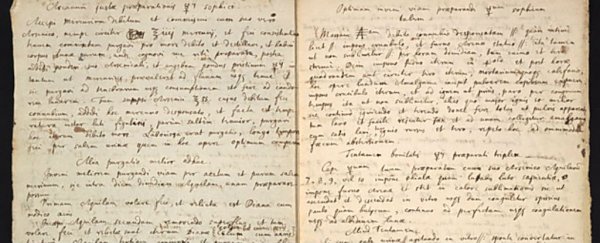A 17th century manuscript handwritten by Sir Isaac Newton has just been purchased by the American Chemical Heritage Foundation (CHF), and after spending decades locked away in the private collection, its incredible contents have finally been made public.
The document, which includes descriptions of experiments performed by Newton, plus writings from another well-known chemist the time, George Starkey, outlines a recipe for "philosophic mercury" (or "sophick" mercury for short), which was thought to be a key ingredient in the creation of the Philosopher's Stone - a mythical substance believed to have the capacity to turn lead, iron, mercury, or copper into gold.
"Philosophic mercury was [thought to be] a substance that could be used to break down metals into their constituent parts," James Voelkel, CHF's curator of rare books, told Emma Stoye at Chemistry World. "The idea is if you break the metals down, you can then reassemble them and make different metals."
The title of the document, which was written entirely in Latin, has been translated as, "Preparation of the [Sophick] Mercury for the [Philosophers'] Stone by the Antimonial Stellate Regulus of Mars and Luna from the Manuscripts of the American Philosopher."
The text has been identified as a copy of an earlier document with the same title, written by high-profile 17th century alchemist, Eirenaeus Philalethes, which Newton used as a reference text for his own alchemical experiments. According to Chemistry World, the first known printed version of this recipe was published in 1678, so Newton could have written out his own copy prior to that.
Alchemy refers to an ancient philosophical and spiritual discipline that combined chemistry with metal work, medicine, astronomy, and physics. The Magnum Opus (translated from Latin as "Great Work") of alchemy was successfully piecing together the Philosopher's stone, which during the Middle Ages through to the 17th century was believed to not only have the power to impart great riches from base metals, but could also grant eternal life.
For centuries, the Philosopher's Stone was the most sought-after object in alchemy, until scientists figured out that everything it promised was entirely impossible and not even worth pursuing.
It's not clear if Newton ever actually attempted the philosophic mercury recipe he'd copied from Eirenaeus Philalethes - thought to be the pseudonym of Harvard-educated chemist George Starkey, one of the US's first published scientists - but Voelkel told Chemistry World it "would not have been out of character" for him to have attempted it.
Even if he didn't, we do get to see what other experiments he was working on at the time, thanks to the notes he scribbled around the copied mercury recipe.
"It's often the case with Newton's manuscripts that if they lie around long enough he turns them over and writes something else on the back," says Voelkel. "In this case there is a note of an experiment that he did. It's a recipe for distilling a volatile spirit out of lead ore … which corresponds nicely with Newton's interpretation with various alchemical authors."
The document had originally been sold with dozens more by Newton's relatives into private collections during the 1930s, and since then have been making their way back into public institutions, including Newton's old research grounds - the University of Cambridge in the UK.
Since purchasing this particular document, the Chemical Heritage Foundation has announced that it's been scanned, and will be uploaded to the Chymistry of Isaac Newton Project, an online database hosted by Indiana University, which anyone can access for free online.
"The collection is gigantic … the estimate of Newton's alchemical output is something like a million words in his own hand," says Voelkel. "This is just another little page in a corpus of hundreds and hundreds of documents."
